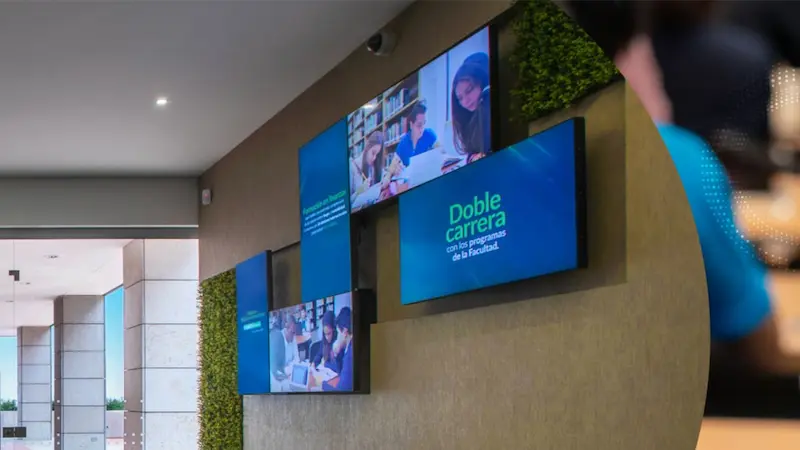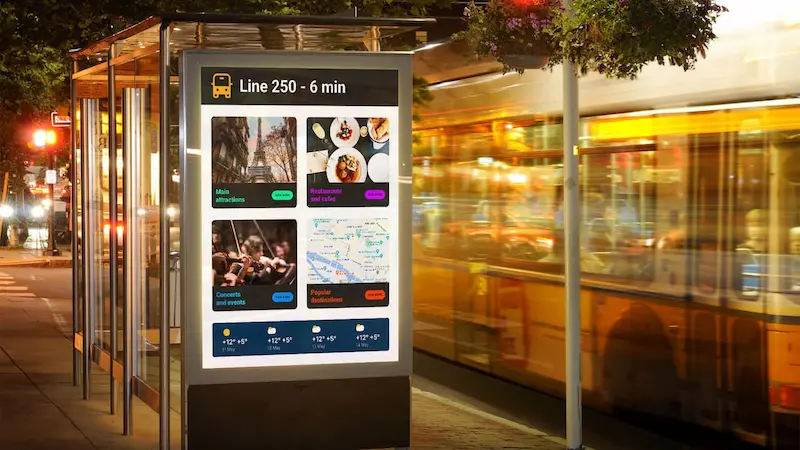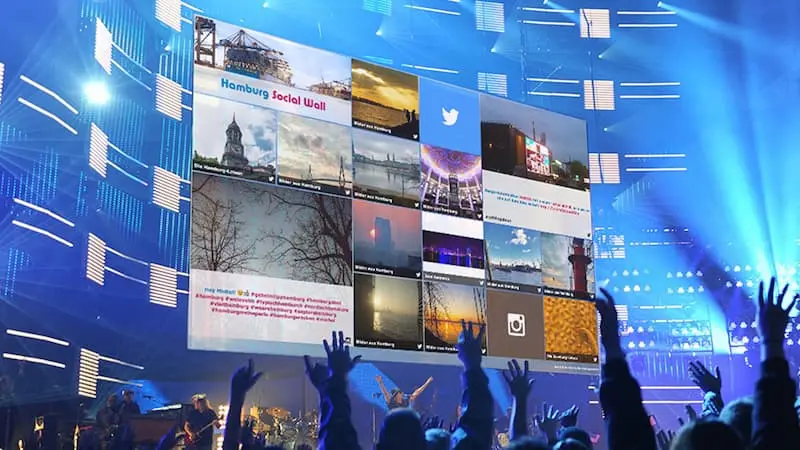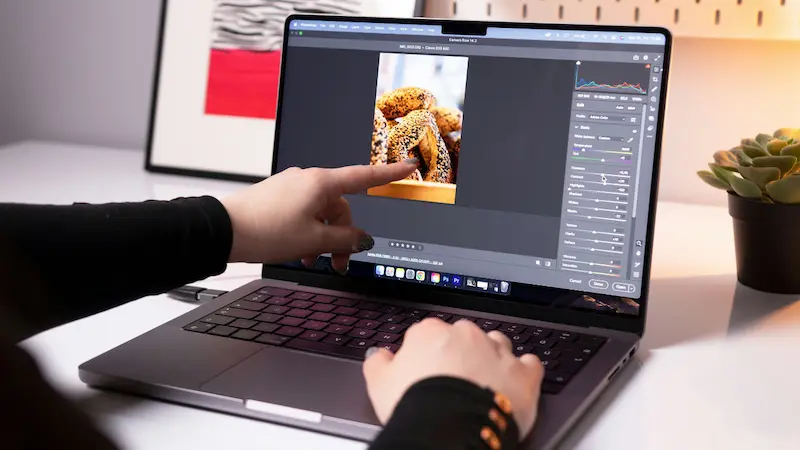
Table of Content
If you think that video walls are those larger-than-life displays so crisp and clear that you stop and stare, then you’re right. But a lot goes into producing that effect on people. The rules for creating stimulating video wall content take it a notch further than with regular digital signage displays. But you don’t have to go searching any further because we have everything you need to know right here. In this guide, we’ll cover the ins and outs of creating a kick-ass video wall content strategy that turns your message into an experience.
Before we get started on strategy, do you know how to set up a video wall? Video walls can be made in several ways: You can use regular TVs, special commercial displays, or even displays with no bezels for a truly seamless look.
However, creating content for these displays can be tricky because of their unusual dimensions. It's important to plan ahead and make sure your content fits perfectly. Additionally, you'll want to be able to control your video wall remotely, which is where tools like Look digital signage come in handy.
Key Components of a Successful Video Wall Content Strategy
Visual Impact: Video walls are supposed to command attention. Therefore, your content needs to be visually stunning. This means high-resolution visuals, bold colors, dynamic motion graphics, and clear, concise messaging.
Content Diversity: Video walls can display a variety of content types. A successful strategy will use this diversity to keep the audience engaged by displaying animations, live video feeds, data visualizations, social media feeds, and even interactive elements.
Scalability and Adaptability: Video wall configurations can vary greatly in size and shape. Content should be designed with scalability in mind, so it can be adapted to fit different aspect ratios and resolutions without losing visual impact or message clarity.
Identify Objectives and Target Audience
Set Objectives for Video Wall Content
This is the most important stage because it will define the type of content and technologies you will use. You need to establish what you want to achieve with your video wall. Are you looking to increase brand awareness, drive sales, inform visitors, or simply create a captivating ambiance?
With defined objectives, identify the people who will be interacting with your video wall. Understanding their demographics, interests, and preferences will help you tailor your content to resonate with them. For example, if your video wall is located in a corporate lobby, your target audience might be employees, clients, or partners. If it's in a retail space, your audience might be potential customers.
Understand and Segment Your Target Audience
At this stage, you’ll need to research to gather demographic data (age, gender, location, etc.) and psychographic data (interests, values, lifestyles). It's also important to analyze their viewing habits and preferences, such as what types of content they engage with and how long they typically spend looking at a video wall.
Once you have a comprehensive understanding of your target audience, you can segment them into smaller groups based on shared characteristics. This will allow you to create more targeted content that resonates with each segment. For example, if your video wall is in a shopping mall, you might segment your audience by age group, with different content for teenagers, young adults, and families.
Types of Content for Video Walls
Wayfinding information: If you have a large establishment, video walls are especially effective in assisting visitors to find their way through interactive maps, directories, or schedules.
Infotainment: With video wall content, the limit is your imagination. Everything your audience would love to see, whether that’s viral videos or breaking news, you can display it simultaneously and keep everyone stimulated.
Interactive content. You can be sure that viewers would be happy to interact with your video wall. That could be through gamified content with the promise of a reward, QR codes that lead to loyalty programs exclusive offers, or even a virtual demonstration of your products.
Sponsored ads: Dozens of businesses would jump at the opportunity for exposure through your video wall. It’s a good chance to sell ad space and maximize the ROI of your investment.
Social walls: Sway your audience and make them part of the action by displaying user-generated content and event hashtags. Most of your consumers would love to be part of your brand story.
Call to action. Prompt your audience to take action by displaying straightforward and prominent calls to action.

Content Creation and Curation
Develop a Content Plan and Calendar
A content plan and calendar are important to keep the video wall experience consistently stimulating. After identifying your content types, plan a time slot for each. Pay attention to the length of each content piece since different viewer segments will have different attention spans. For example, attention-grabbing visuals are more suitable for peak hours, while informational content might be better suited for quieter periods. A content calendar will help you create content well in advance for major holidays and seasons so that updates are always on time.
Source High-Quality Content and Multimedia Assets
Start thinking about content sources early on in the project, even if you won’t make a final decision immediately. This will help you align content needs with CMS capabilities and budget considerations.
Many CMS platforms offer integrations with social media, YouTube, RSS feeds, and other sources. Weigh the pros and cons of creating content in-house versus using third-party providers. Consider the cost, customization, expertise, and volume of content needed to make the most suitable choice for your project.
Regardless of your chosen sources, prioritize high-quality assets that are optimized for the specific resolution and aspect ratio of your video wall.
Implement Branding and Promotional Messages

Your video wall is a great tool to strengthen your brand image and advertise the products or services you offer. Add your logo, color scheme, and other visual aspects to ensure that the video wall contributes to your overall brand message. Add some animations or transitions that are consistent with the voice and tone of your brand. It might not be a good idea to overwhelm your audience with constant advertising. There should be a good balance and subtle transitions between promotional content and informational and entertaining elements.
Consider Aspect Ratio When Create a Content
When you find your entire video wall has black bars or the content is distorted, it's often an issue with the aspect ratio. Aspect ratio is the relationship between the width and height of your display. Your content’s aspect ratio must match the combined aspect ratio of the entire video wall.
A single screen usually has an aspect ratio of 16:9. For video walls, you need to calculate the combined aspect ratio based on your screen configuration. For instance, a 2x2 video wall (two screens wide and two screens high) maintains the 16:9 aspect ratio, while a 1x2 configuration (one screen wide and two screens high) would have an aspect ratio of 16:18.
Common video wall layouts and their aspect ratios include:
- 1x2 (landscape): 32:9
- 2x2 (square): 32:18
- 3x2: 48:18
- 1x4 (portrait): 9:64
Your digital signage content manager will help you design content that perfectly fits your video wall’s specific dimensions. If you’re using Look CMS, you'll need to create individual pieces of content that fit within the "zones" or "sections" you envision on your video wall.
For instance, let's say you want a video wall with three zones: two side-by-side in landscape (16:9) and one larger zone above them in portrait (9:16). You would create three separate pieces of content with these aspect ratios and then arrange them within Look DS to form your video wall.
Content Deployment and Management
The best thing is that you only need one solution for this: A robust content management system. It will be your central hub for organizing, scheduling, and updating content on your video walls. With Look Digital Signage CMS, for instance, you can create content playlists and schedule them so that playback is automatic. The schedules can be daily, weekly, or even monthly, to include recurring content as well as special event promotions.
Optimize Content Layout and Display Sequencing
Thematic Zoning: Create layouts from your CMS that divide your video wall into zones with different content items. For example, a retail video wall could feature a "New Arrivals" zone showcasing the latest products, a "Brand Story" zone highlighting company values, and a "Customer Spotlight" zone displaying user-generated content.
Visual Hierarchy: Use composition techniques to create a visual hierarchy that directs attention. Larger visuals, brighter colors, and movement naturally draw the eye. Place key messages or calls to action within these focal points to maximize their impact.
Narrative Sequencing: Think of your content as a series of chapters in a story. Each visual should flow seamlessly into the next, to build anticipation and guide the viewer through the narrative. Use transitions that create a sense of continuity and momentum.
Pacing and Rhythm: Vary the pace and rhythm of your content to prevent monotony. Combine fast-paced, attention-grabbing visuals with slower, more contemplative moments. It will create a dynamic viewing experience that holds attention and prevents viewer fatigue.
Contextual Triggers: Add contextual triggers that adapt content based on real-time factors. For example, a weather-triggered display could showcase umbrellas during rainy days or sunscreen during sunny days. It’s an excellent way to personalize the experience and delight your viewers.
Incorporate Remote Management and Monitoring Tools
Your CMS has your back on remote management. From virtually anywhere, you can update content, adjust schedules, and troubleshoot issues from a web-based interface and the changes will reflect immediately.
To get real-time insights into the health and performance of your video wall network, you can use remote monitoring tools. They will track display uptime, content playback status, and environmental conditions (e.g., temperature, humidity), so you can proactively identify and address potential problems before they escalate.

Measurement and Optimization
Ultimately, the success of your video wall content strategy will be determined based on how effectively it captures and retains your audience’s attention. To make sure that your investment pays off, you should measure and adjust consistently. Collect data on viewership patterns that help you understand what succeeds with your target audience and what does not. For this, you can try a combination of quantitative and qualitative data. Heatmap tracking can show which areas of the screen attract the most attention, while facial recognition technology will provide information on how emotionally responsive to each type of content your viewers are.
Surveys and feedback pop-up forms on the actual video wall can be a valuable source of information on what type of screens people tend to pass on and which kind of content they think can be improved. From there, you can experiment with different content types and messaging to improve your strategy.
Difficulties in Deploying the Video Wall
One primary difficulty with video walls is synchronizing content across multiple screens. It requires precise coordination so that the visuals appear seamless and uninterrupted. This synchronization is managed by sophisticated software that can handle the distribution and timing of content across different panels, which often requires specialized technical skills to set up and maintain.
Another challenge is that quantifying the return on investment (ROI) of a video wall can be tricky. While increased brand awareness and customer engagement are valuable outcomes, attributing specific revenue figures to video wall content can be difficult.
Real-Life Examples
Shiseido Global Innovation Center
Shiseido installed an immersive video display for their new research center in Yokohama, Japan to replace their conventional large-scale LED display system that showed bezels between separate modules. Sony provided them with the world’s largest Crystal LED display, with bezel-less modules for a continuous and seamless visual experience. The video wall created a captivating and awe-inspiring experience that enabled visitors to full immerse in the content.
Adidas Flagship Store in South Africa.
Adidas deployed two visually striking video walls in Sandton, South Africa to draw customers into the store. These walls, positioned on each side of the entrance, consist of nine 48-inch screens arranged in a 3x3 format. They display vibrant full-HD content that showcases Adidas' latest products and sportswear launches.
Conclusion
Digital signage success doesn’t happen by chance, and since you’re reading this, it means you already have the tools and knowledge to be successful. A well-defined video wall content strategy will guide the steps of your entire team so that everyone knows where to look and the steps to take to achieve your defined objectives. And speaking of tools, you can never go wrong with a video wall solution specially made with your needs in mind. We are talking about pre-designed templates for easy content creation, advanced scheduling capabilities, and remote management. Look CMS is your go-to strategy partner to realize the full potential of your video wall. Want to see what I mean? Sign up for a 14-day trial period where you’ll get all the features without limitation, it’s free!







